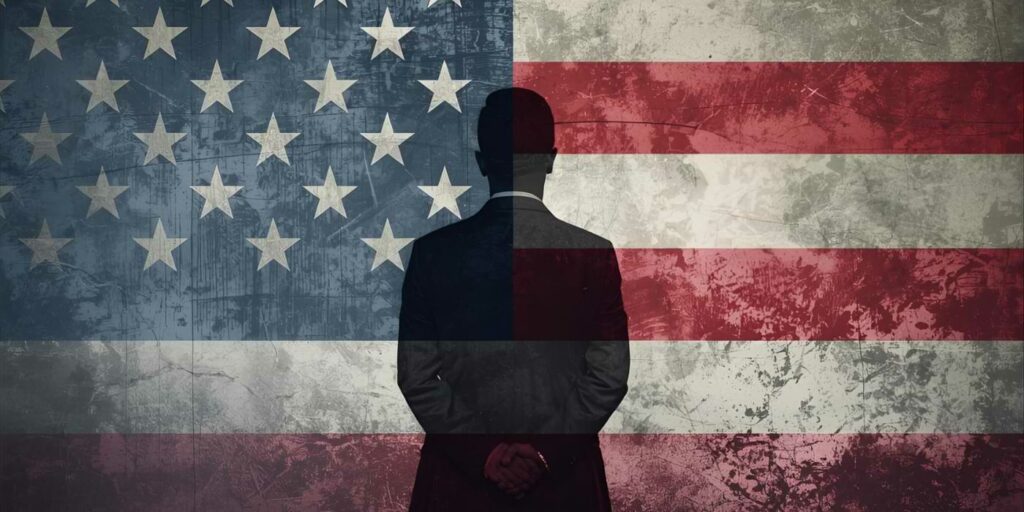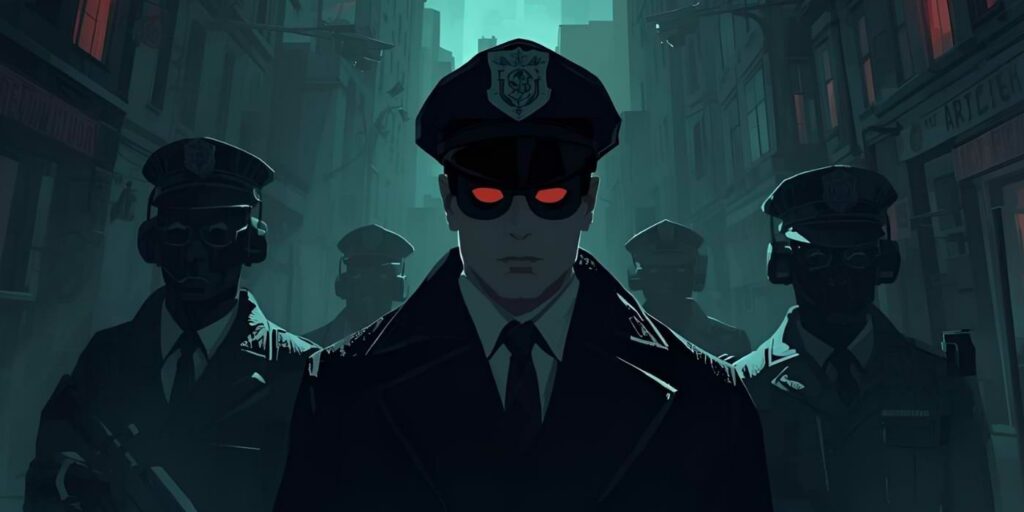Fascism in the United States — it’s a phrase that alarms many, yet it’s increasingly becoming part of the national conversation. Are we truly seeing signs of it today? This piece explores the historical playbook of fascism to examine whether American democracy is showing symptoms of authoritarian drift.
Is the United States still the land of the free and the brave? For many, that once-assured answer feels more uncertain than ever. Although freedom and courage were the principles the nation was founded on nearly a quarter of a millennium ago, accusations of rising fascism in the United States are growing louder.
To understand what’s really happening, we’ll first turn to history—examining how fascism rose in other nations—to identify the early warning signs. Then we’ll compare it to the current political and social landscape in the U.S. By the end, you’ll be able to judge for yourself whether or not the U.S. is following the authoritarian playbook—and what that could mean for its people and the nation’s future.
What is fascism?
Before we dive into fascism in the United States, let’s define the word. Fascism is a political philosophy, or theory of government, that emerged in 20th-century Europe. It’s best understood as a form of radical, authoritarian ultranationalism that prioritizes the nation over the individual, with the individual existing in service of the nation.
In short, fascism is a totalitarian system of government that rejects liberal democracy, communism, and traditional conservatism, instead calling for a single, all-encompassing party to forge a spiritually and racially unified national community.
Table of Contents
A look through history: how fascism comes to power

“The reversion to fascism is a deep-seated fear of modern democratic societies,” quote from Der Spiegel
I first began my investigation of possible fascism in the United States by examining two recent media events that raised serious concerns for preemptive compliance and censorship. Then I realized that to fully understand what’s unfolding, we must look backward.
History offers warnings that feel uncomfortably familiar. Let’s now turn to the past to see how the United States may be following a terrifyingly familiar playbook. Whether we’re tracking the potential rise of fascism in the United States or the spread of the ideology in other nations, it helps to begin with the ideology’s defining traits.
As you will soon see from the three stories we’re going to explore, fascist regimes typically exhibit several core characteristics. These include:
- Exclusionary ideology: They obsess over defining who belongs to the “true nation” or “race” and who must be excluded, persecuted, or eliminated—often targeting ethnic minorities, immigrants, liberals, or leftists.
- Cult of the leader: A single charismatic ruler demands absolute loyalty and centralizes all power in their hands.
- Militarism and violence: Fascists glorify war, youth, and national unity, promoting political violence as a cleansing or unifying force.
- Single-party state: Opposition parties, labor unions, and democratic institutions are dismantled or absorbed into the regime.
- Myth of national rebirth: Fascist movements claim the nation is in decay and promise redemption through the purifying action of their movement.
With these defining traits in mind, we can now examine how fascism first took root. Then, we can compare those emerging warning signs to determine the current state of fascism in the United States.
Exhibit 1: Mussolini’s fascist reign (1920s)
Fascism began as a movement galvanized by post-World War I turmoil and inspired partly by the revolutionary energy of 1917 Russia. National Geographic describes it as “a political movement that harnessed discontent with a potent brew of nationalism, populism, and violence”—a mixture that soon engulfed Italy and much of the world.
The ideology first emerged in 1919 when Benito Mussolini founded the Partito Nazionale Fascista (National Fascist Party). Exploiting widespread resentment over Italy’s so-called “mutilated victory” after World War I, Mussolini led his followers—the Blackshirts—in violent attacks on socialist organizers, labor leaders, and local officials. The Italian government, sharing the fascists’ anti-socialist fears, largely tolerated the violence.
This campaign of brutality solidified Mussolini’s image as a decisive, powerful leader capable of restoring order. When socialist-led strikes erupted, he framed the government as weak and positioned himself as the nation’s savior. In October 1922, he marched on Rome and was invited into government by the very elites who believed they could control him.
Pre-compliance in action: Industrialists, landowners, and conservative politicians—afraid of socialism—funded and enabled Mussolini’s rise, assuming his movement would protect their interests. Their willingness to appease him and tolerate violence helped dismantle Italy’s democratic institutions and paved the way for two decades of authoritarian rule, censorship, and a propagandistic police state.
Exhibit 2: Fascism in Nazi Germany (1930s-40s)
From Italy, fascism spread rapidly across Europe after World War I, although none were more destructive—or more widely emulated—than the regime established by Adolf Hitler in Germany, which is why we will explore it most in-depth with information from the Holocaust Encyclopedia.
Fascism found fertile ground in a nation humiliated by military defeat, crippled by reparations, and destabilized by political infighting. The democratic Weimar Republic faced economic collapse and widespread resentment over the Treaty of Versailles, creating an opening for extremist movements promising national restoration.
Hitler joined the German Workers’ Party in 1919 and quickly reshaped it into the National Socialist German Workers’ Party (NSDAP)—the Nazi Party. Despite the word “socialist” in its name, the Nazi platform rejected socialism, liberalism, and democracy in favor of an ultranationalist, racial vision of the German Volk—the “people.”
In 1923, Hitler and his paramilitary followers attempted to overthrow the Bavarian government in the failed Beer Hall Putsch, modeled on Mussolini’s March on Rome. Though imprisoned afterward, Hitler used his trial and subsequent book, Mein Kampf, to broadcast his ideology and recast himself as Germany’s destined savior.
Upon his release, the Nazi Party focused on gaining power through legal and electoral means. By exploiting public fear, economic despair, and anti-communist sentiment, the Nazis built mass support through relentless propaganda, mass rallies, and the paramilitary Sturmabteilung (SA).
In January 1933, President Paul von Hindenburg appointed Hitler the chancellor, believing he could be controlled. Within months, Hitler manipulated a suspicious fire in the Reichstag (parliament) to declare a state of emergency, suspend civil liberties, and eliminate political opposition. The Enabling Act of March 1933 granted him the power to rule by decree—effectively dismantling German democracy.
By 1935, the Nuremberg Laws stripped Jews of citizenship. In 1938, Germany annexed Austria in the Anschluss, then occupied the Sudetenland, expanding its borders under the guise of ethnic unification. These aggressive moves were preludes to a catastrophic world war and the genocide of Europe’s Jews.
Pre-compliance in action: Many conservative elites, industrialists, and media magnates enabled Hitler’s rise, believing his movement would stabilize the country and protect their interests against communism. They underestimated his ambitions, funding the Nazi Party and cooperating with its propaganda machine.
As we see when examining the potential emergence of fascism in the United States, many businesses chose to pre-comply at the time. The business community and press largely self-censored, aligning with Nazi goals to preserve influence and avoid persecution.
Meanwhile, the complicity of the elite allowed Hitler to consolidate total control, transforming a fragile democracy into a fascist dictatorship that weaponized nationalism, fear, and bureaucracy to commit unprecedented crimes against humanity.
Exhibit 3: Erdoğan’s fascism today (2000s-present)
It’s worth clarifying, as we examine the possible emergence of fascism in the United States, that fascism’s methods didn’t vanish with the 20th century—they’ve evolved. Modern Turkey under Recep Tayyip Erdoğan shows how democratic systems can slide toward one-man rule through fear, nationalism, and institutional compliance.
A former mayor of Istanbul, Erdoğan rose from imprisonment in 1998 for reciting a nationalist poem to becoming prime minister in 2003 and transitioning to President in 2014, steadily consolidating power across both roles. The New York Times credited his ascent to “a mix of charisma and nationalistic fervor.” Once in power, he gradually dismantled the checks that restrained him—purging judges, generals, journalists, and political opponents.
After the failed 2016 coup, Erdoğan expanded his authority further, jailing tens of thousands and tightening control of the press. By 2018, hours before his inauguration as president, he issued a 143-page decree that restructured the entire government, fired 18,000 civil servants, and appointed his son-in-law as finance minister.
Pre-compliance in action: Turkish institutions began censoring themselves. Media outlets dismissed critical reporters, businesses echoed state talking points, and courts ruled in favor of the regime—all without explicit orders. This climate of voluntary submission shows how modern authoritarianism thrives not only through repression but through fearful cooperation.
How fascist attitudes arrived in the United States

And now we’ve hopefully arrived back at our central question with enough information to seek some answers: is fascism in the United States truly on the rise? First, I invite you to briefly consider the words of Robert Kagan, when he didn’t hold back any punches in his powerful article for The Washington Post titled “This is how fascism comes to America.”
“This is how fascism comes to America, not with jackboots and salutes (although there have been salutes, and a whiff of violence) but with a television huckster, a phony billionaire, a textbook egomaniac “tapping into” popular resentments and insecurities, and with an entire national political party — out of ambition or blind party loyalty, or simply out of fear — falling into line behind him,” Robert Kagan, The Washington Post, May 18, 2016.
These words were written nine years ago, back in 2016. Kagan predicted elements of the future United States a decade in advance. And as we can see from the rise of fascism in Nazi Germany, the ideology can grow not just through violence and charisma, but through the acquiescence of institutions that choose survival over resistance.
So now, let’s refer back to our earlier model and see if the five characteristics of a fascist regime are present in the current United States government. Is there fascism in the United States? The answer might surprise both sides.
Evaluating the 5 signs of fascism in the United States

While the United States currently does not meet the formal historical threshold of a fully realized fascist state—lacking, for instance, a single-party government or an official, absolute dictator—a clear and alarming adoption of proto-fascist and authoritarian characteristics is evident in the rhetoric and political actions, especially within the MAGA (Make America Great Again) movement.
A careful, honest look at the U.S. political environment reveals the governing party has internalized many of the movement’s most dangerous psychological and ideological mechanisms. Let’s break down the characteristics of fascism in the United States piece by piece to see what alarming changes are underway.
1. Exclusionary ideology
A core sign of rising fascism in the United States is the definition of a “true nation” and the active exclusion of out-groups. Political figures aligned with this movement often employ a “traditionalist civil religious jeremiad,” a narrative that frames America as being in a state of decay caused by liberal social change.
This rhetoric often implicitly, and sometimes explicitly, elevates the white, heterosexual, Christian identity as the foundation of the “true nation,” thereby legitimizing the defense of this demographic’s perceived loss of privilege.
This exclusionary drive extends to social commentary, with high-profile conservative voices publicly decrying childless individuals as even being a threat to national stability, suggesting the ideal citizen must conform to a specific, traditional family model for the sake of the state. In public remarks and interviews (notably in 2021), current Vice President J.D. Vance argued that childless adults have “no physical commitment to the future of the country,” suggesting they are “less invested in America’s success.”
Most disturbingly, this ideology manifests in action through the significant escalation of ICE raids and indiscriminate deportation agendas. Multiple lawsuits and reports, including those from the ACLU and Human Rights Watch, allege that ICE enforcement actions have relied on racial profiling or appearance-based targeting. This active scapegoating and targeting of immigrants and minorities perfectly aligns with the initial stages of the exclusionary playbook of fascism in the United States.
Meanwhile, Queer rights are being rolled back through targeted legislation, book bans, and rhetoric portraying LGBTQ+ people as threats to children or public morality. Women’s rights, including abortion rights, face coordinated legal attacks that reduce bodily autonomy to a political bargaining chip. Together, these campaigns reinforce systematic oppression—a hierarchy of worthiness that determines who is fully American and who is not.
2. A Cult of the leader
Fascism is inseparable from the figure of a single, charismatic dictator demanding absolute loyalty. While fascism in the United States cannot be fully achieved while democracy is still in power, it’s important to remember how other fascist leaders also started their political careers in legitimate ways.
Meanwhile, the MAGA movement exhibits classic “cult-like” characteristics, marked by a deep, emotional, and symbolic identification with the leader rather than a purely ideological one. Supporters often demonstrate selective blindness toward the leader’s inconsistent actions, viewing legal setbacks or controversies as proof of his authenticity and victimhood, reinforcing a persecution complex.
This intense loyalty requires followers to engage in performative outrage, leading them to blindly hate and reject the leader’s declared enemies—from journalists and political opponents to institutions like the FBI and Justice Department. This dynamic is sustained by the leader’s consistent use of gaslighting (such as contradicting provable facts) and his successful campaign to delegitimize any institution, media outlet, or fact-source that offers critique, demanding that followers place their trust and belief solely in him.
Continued Reading: Cast with Caution: A Deep-Dive into Donald Trump’s Controversies
3. Militarism and violence
An obsession with national unity through aggressive displays of strength and political violence against enemies is a key fascist trait. Fascism in the United States accusations recently brewed when some right-wing commentators and officials have rhetorically revived terms like “Department of War” to project strength, though no official change or executive order has occurred. In fact, there is now an Executive Order to restore the U.S. Department of War.
Domestically, while the deployment of the National Guard for border security and disaster response is constitutional, the recent heavy use of the Guard in cities to respond to anti-racism protests contributes to a general atmosphere of militarized domestic presence that can be used to suppress dissent.
This is coupled with escalating rhetoric that normalizes political violence, where high-profile figures frame their political opposition—the “radical left”—as a domestic terror threat that must be “dismantled and destroyed.” Just watch this clip of Vice President Vance blaming “left-wing radicals” for the death of controversial media figure Charlie Kirk.
This language weaponizes the power of the state to target political enemies, a chilling echo of the historical fascist playbook. Meanwhile, there doesn’t appear to be proper data to back up these claims, further indicating the spreading of fascism in the United States as groups are falsely labeled and weaponized as pawns.
4. The single-party state
When examining potential fascism in the United States, it’s key to remember that fascism seeks the total suppression of political opposition, democratic institutions, and independent labor. While the U.S. remains a multi-party system, political analysts have increasingly warned about the process of “democratic backsliding” driven by systematic attacks on core institutions.
These actions include unprecedented attempts at election subversion, the use of partisan gerrymandering to suppress voter power, and the vilification of the Justice Department, FBI, and the courts when they are not politically favorable. Collectively, these efforts seek to dismantle the checks and balances designed to prevent single-party dominance.
Furthermore, independent labor, long considered a bulwark against authoritarianism, has been systematically weakened by political alignment. In the U.S., for instance, one major party has increasingly endorsed right-to-work laws, which prohibit union security agreements (i.e., requiring payment of dues or fees) and thereby inflict financial and organizational strain on unions.
Empirical research indicates that RTW laws lead to significant declines in union density and wage levels, and reduce unions’ capacity for electoral mobilization — a dynamic consistent with the fascist objective of neutralizing autonomous organizations capable of political challenge.
5. National rebirth and decline
Now we’ve arrived at our final point in evaluating fascism in the United States. The narrative of decay and subsequent rebirth is the ideological fuel for fascism, and this is embodied perfectly by the campaign slogan, “Make America Great Again.” This slogan operates on the core premise that the nation is currently in a state of calamity and decline, which is often blamed on the cultural changes and policies of previous, non-aligned administrations (e.g., Obama and Biden).
By creating this pervasive sense of national crisis—often through rhetoric unsupported by empirical facts—the movement positions itself and its leader as the sole force capable of a “cleansing action” and restoration. The promise is not a better future through democratic means, but a “rebirth” into a mythical, glorious past, a promise that bypasses the need for democratic debate and justifies any means necessary to achieve its vision.
If that doesn’t sound like a clear example of fascism in the United States, then I’m not sure what does. Though not all criteria have been met to declare the United States to be a fully realized fascist state, certainly, there are enough proto-fascist and authoritarian characteristics to alarm lovers of freedom.
Don’t let the neighbors hear you complain

As we wind down our exploration of fascism in the United States, one phrase comes to mind: “Don’t let the neighbors hear you complain.” It once defined life under totalitarian regimes—and it feels like it’s becoming disturbingly relevant again.
Fascism in the United States may not have yet emerged in a full-fledged fascist state, but when ordinary citizens grow afraid to criticize their leaders or express dissenting opinions, the seeds of authoritarianism have already been planted.
This atmosphere of fear is not new to America. We’ve seen echoes of it before, in the McCarthy era, when suspicion and accusation silenced millions and neighbors turned on each other. The Red Scare punished thought itself. Today, we face a quieter, digital version of that same terror: public shaming, job loss, and surveillance for speaking against power.
When people whisper instead of speak, when journalists self-censor, when satire becomes dangerous, freedom is already retreating behind closed doors. When citizens measure their words out of fear, freedom is already in retreat. Does that sound like true freedom to you? Because, no matter how safe you think you are, fascist regimes consume every individual.
Closing words on fascism in the United States
Fascism in the United States has not (thankfully) completely spread into every aspect of rule at the time I write this blog. But I fear for the future, as its contours are visible—in the manipulation of truth, the persecution of out-groups, and the public’s growing acceptance of intimidation as normal politics.
Without vigilance and change, we should indeed be afraid. What we’ve uncovered is not freedom. And it’s certainly not democracy. So what will we do when they come for us—not with tanks or jackboots, but with lawsuits, firings, and silence?
History offers both warning and hope: fascism feeds on fear, but it falters before courage. At times like these, I feel proud that voices like Jon Stewart and Stephen Colbert (at least for now) are speaking out for the daily injustices that otherwise appear to be swept under the rug.
The voices of such media figures—and their teams and writers—should remind us that our democracy is not a gift that endures on its own—it survives only when defended. If history teaches us anything, it’s that the American people are resilient.
So I will conclude our exploration of fascism in the United States with this: The question is not whether freedom can endure, but whether we will choose to protect it. Which side of history do you plan to be on when it happens this time?
Continued Reading: Corporate Silence: The Dangerous Politics of Convenience
